Martial Arts & Qigong
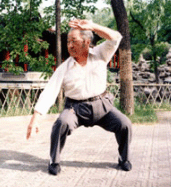 尹派八卦掌的故王敷 |
八卦掌 Baguazhang - Circling, Unending, Flowing Baguazhang is an art that was taught and practiced in the Emperor's palace towards the end of the Qing Dynasty. Created by Dong Haichuan (董海川), influenced by mysterious sources probably related to the Quanzhen (全眞) Daoist sect, the art features circling, unending, and flowing movements. Baguazhang has throughout the years absorbed the best of other famous Chinese martial arts, and thus has a wide plethora of techniques, weapons, and skills. Unfortunately, there are today very few left who can effectively utilize the magnificent skills that this art possesses. Dong Haichuan's first disciple Yin Fu (尹福) is famous for having protected and escorted the Empress Cixi out of the palace to safety during the Boxer Rebellion. The art of Baguazhang has always been centered in Beijing, where it was created and practiced, but also moved out to Hebei, Tianjin, Shandong, and even Hong Kong and Taiwan. There are four major styles of Baguazhang: the Yin (尹) style, the Cheng (程) style, the Liang (梁) style, and the Fan (樊) style.
|
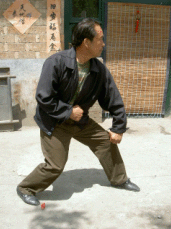 楊凡生演車派形意拳的提水勢 |
形意拳 Xingyiquan - Direct, Powerful, Compact Xingyiquan is an old art that has changed over the centuries, but finally crystallized into today's art almost 200 years ago. Xingyiquan features compact, powerful movements and issuing of force from any part of the body. Xingyiquan was refined and crystallized by Li Luoneng (李洛能), who learned Dai style Xinyiquan from Dai Longbang (戴龍邦). Li and Li's students Che Yizhai (車毅齋) and Song Shirong (宋世榮) taught Xingyiquan in Shanxi province, while Li's other students Guo Yunshen (郭雲深) and Liu Qilan (劉奇蘭) took Xingyiquan to Hebei province, where it spread and is still taught today. There are four major styles of Xingyiquan: the Shanxi Che (車) and Song (宋) styles, and the Hebei Guo (郭) and Liu (劉) styles. |
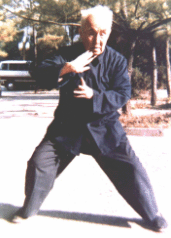 陳氏太極拳故洪均生 |
太極拳 Taijiquan - Soft, Yielding, Transforming Taijiquan is an old art that was born in the Chen Village in Henan province. There, Chen Changxing (陳長興) taught Yang Luchan (楊露禪) the art, even though the art had been kept within only the Chen family for centuries. Yang Luchan 'the invincible' made the art famous when he defeated many in Beijing, ultimately becoming a trainer at the Emperor's palace. Taijiquan is an art that teaches yielding, seeming-softness, and returning one's opponent's power back to him. Although the image of taijiquan is very soft and tranquil, in fact the training is harsh and far from easy. There are five major styles of Taijiquan: the Chen (陳) style, the Yang (楊) style, the Wu (吳) style, the Wu/Hao (武/郝) style, and the Sun (孫) style. |
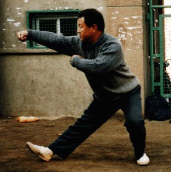 故康志強演七星螳螂拳勾步 |
螳螂拳 Tanglangquan - Lightning-Fast, Multiple-Angle Strikes Tanglangquan, or 'Praying Mantis Style' is an old style originating in Shandong province, and today mainly practiced in Shandong, Liaoning, and Jilin. Tanglangquan was originally the refinement and aggregation of 18 of the best fighting styles, including Through-the-Back Fist (通背拳), Mandarin Duck Legs (鴛鴦腿), and Emperor's Long Fist (太祖長拳), but also the addition of Praying Mantis hands. Tanglangquan is particularly known for its blazing speed of continuous attacks, all entering from different angles. There are three main styles of Tanglangquan: Seven-Star (七星), Plum Flower (梅花), and Six-Combination (六合); however, there are also countless other lesser-known styles. |
|
少林拳 Shaolinquan - Stable, Central, Vast Base of Martial Knowledge The arts of the Shaolin temple, once restricted to only the Eight Part Brocade (八段錦), Marrow Washing Classic (洗髓經), and 18 Arhats Style (十八羅漢拳), soon added the famous Crazy Demon Staff (瘋魔棍), and ultimately came to encompass a great body of martial knowledge that no single person could possess at once. Vigorous styles like Dahongquan (大洪拳), Xiaohongquan (小洪拳), Kanjiaquan (看家拳), Cannon fist (炮拳), the pinnacle of the arts Xinyiba (心意把), and various weapons like Night-fork Staff (夜叉棍), Five Tigers Herd of Sheep Staff (五虎群羊棍), and Bodhidarma Sword (達摩劍). Unfortunately, many methods have already been lost, because of persecution of the monks and destruction of the temple throughout the Cultural Revolution, but also because monks, who have no attachment to the world, were strict in choosing who to pass their skills to, and often simply did not. Although not everything was preserved, there is still a lot of material to learn that can be found in the traditions of the (now restored) Shaolin temple today. In general, Shaolinquan is not overly this or that, as it includes a very large amount of material. Certain postures imitating arhats or other Buddhist motifs can be seen fairly often, however, as it is a Buddhist style after all. | |
|
查拳 Zhaquan - Graceful, Quick, Acrobatic Zhaquan, or Chaquan, is a traditional Longfist (長拳) style that has mainly been practiced and handed down by Chinese Muslims (回族). Featuring graceful movements, athletic jumps, and acrobatic maneuvers, Zhaquan also features a large array of weapons and two-man sets. Zhaquan is mainly practiced in Shandong and Henan, but is also widely practiced throughout the rest of China. Although not as popular as some other styles of Chinese martial arts in the West, it remains a very effective style with abundant content; one famous modern master is Zhang Wenguang (張文廣), also a Chinese Muslim, who is ranked very highly in China's wushu organizations, and who was a main factor in the creation of the modern wushu changquan (made famous by movie stars like Jet Li (李連傑)).
| |
|
跆拳道 Taekwondo - Fast Flying Kicks Taekwondo is well-known for its large array of high, flying kicks. In particular, the South Korean government has put a lot of effort and money into spreading Taekwondo throughout the world, as a sort of vessel for Korean culture. However, Taekwondo is actually not a traditional Korean martial art, in that it is a direct descendant of Japanese karate. However, Taekwondo has changed significantly over the years, and has added many techniques to the old karate techniques; however, in form and basic body movement much of the old karate has remained. In the end, Taekwondo is simply a system of learning methods of kicking, using basically mundane body movement.
| |
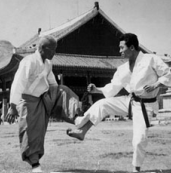 故宋德基와自然流김수 |
택견 Taekgyeon - True Traditional Korean Martial Arts Taekgyeon is one of the only traditional Korean martial arts that has been passed down to the present time nearly unchanged. Taekgyeon escaped near extinction when the only man who continued practicing it, Song Dukgi (宋德基), passed the art to the next generation. Taekgyeon is a competitive martial art featuring kicks, throws, and open-hand blows, and it resembles Chinese kicking methods more than Japanese or modern Korean methods. The art features a rythmic step that is crucial in practice. |
 故塩田剛三 |
合気道 Aikido - Graceful Joint-Locks and Throws Aikido was created by Ueshiba Morihei (植芝盛平) who learned Daito-ryu Aikijujutsu (大東流合気柔術) from Takeda Sokaku (武田惣角), who had learned the art as transmitted by his ancestors. Ueshiba and Takeda are among the greatest martial artists in Japan's history; their ability to lead an opponent's intent, utilize an opponent's energy, and tendency to exhibit extraordinary phenomena were famous. Many of Ueshiba's students transmitted their own personalized styles of Aikido, creating different methods of learning, different techniques, and different terminology. |

 Read about various swindling and problems in the WTF
Read about various swindling and problems in the WTF